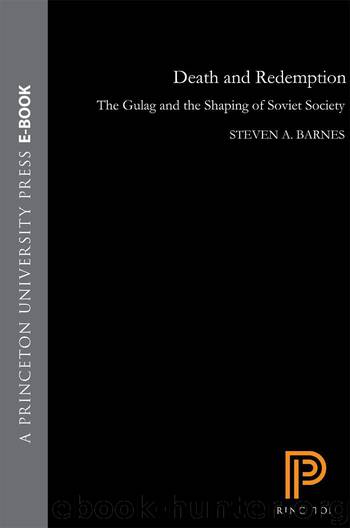Death and Redemption: The Gulag and the Shaping of Soviet Society by Barnes Steven A

Author:Barnes, Steven A.
Language: eng
Format: epub
Publisher: Princeton University Press
Published: 2011-04-04T04:00:00+00:00
Nationality and Postwar Exile
Memoirs from the postwar Gulag attest time and again to the importance of national identity in the organization of postwar prisoner society. As Fel’dman, a prisoner at Steplag, describes it, the camps had a distinctly multinational hue. Ukrainians, Belarusians, Balts, Chinese, Japanese, Germans, and citizens of the people’s democracies—these were the nations of the Gulag. He even remembers “one black man,” a U.S. Army tank captain captured outside the American section of Germany in his tank and given seven years.147
A number of factors explain the particular significance of national identity during the postwar period. First, Soviet authorities starting in the 1930s and especially during the war had shifted toward a conception of the internal enemy that was defined ever more frequently in national terms. Prisoners and deportees increasingly found themselves in camps or exile not for their class status but rather for their nationality. Nationality became a primary organizing principle of Gulag practice. Second, the integration of the western territories and Baltic states into the Soviet Union brought vast new populations to the Gulag that had spent the interwar period in polities organized on the nation-state principle. Nationalism, often in its integral nationalist form, was a dominant ideology in these regions. Many from these regions who found their way into the Gulag were members of nationalist underground organizations and nationalist partisan armies that had fought fiercely against all comers, including Soviet power, in the name of nationality. Third, postwar Soviet policy, especially starting with Stalin’s famous toast to the Russian people, increasingly operated on the basis of a hierarchy of nationalities that raised primarily the Russian and secondarily the other Slavic nationalities above all others.
Nationality was certainly recognized by camp and colony administrators as an crucial element of camp life to be addressed in the postwar era. As one camp and colony Communist Party functionary in Kazakhstan put it in 1946, “In our ideological work, a large place must be taken by the national question.”148 The exact nature of work on “the national question” was never quite clear. Frequently, when talking about their work, camp and colony party members emphasized the necessity of propagandizing the ideas of “Soviet patriotism.”149 At the same time, the actual practices of camp employees generally privileged Russians over other nationalities.
Gulag prisoners and exiles, struggling for survival, latched on to various forms of community as ways to organize their lives in detention. Nationality in the Gulag worked in a number of different ways—first as a positive tie between prisoners on the basis of which they offered help to one another. According to Scholmer, a German Vorkuta inmate attuned to the national groupings in the Gulag, prisoners working in the kitchens tended to favor their conationals.150 Members of various nationalities attempted to find space to continue some cultural traditions that defined their national existence. Thus, in the mines of Vorkuta, where the camp guards refused to go, Lithuanians reportedly performed religious services.151 Western Ukrainians often refused to speak Russian, preferring their native language.152 These national communities were not, of course, undifferentiated.
Download
This site does not store any files on its server. We only index and link to content provided by other sites. Please contact the content providers to delete copyright contents if any and email us, we'll remove relevant links or contents immediately.
| Anthropology | Archaeology |
| Philosophy | Politics & Government |
| Social Sciences | Sociology |
| Women's Studies |
Cecilia; Or, Memoirs of an Heiress — Volume 1 by Fanny Burney(32068)
Cecilia; Or, Memoirs of an Heiress — Volume 3 by Fanny Burney(31463)
Cecilia; Or, Memoirs of an Heiress — Volume 2 by Fanny Burney(31413)
The Great Music City by Andrea Baker(30794)
We're Going to Need More Wine by Gabrielle Union(18641)
All the Missing Girls by Megan Miranda(14771)
Pimp by Iceberg Slim(13789)
Bombshells: Glamour Girls of a Lifetime by Sullivan Steve(13692)
Fifty Shades Freed by E L James(12923)
Talking to Strangers by Malcolm Gladwell(12888)
Norse Mythology by Gaiman Neil(12848)
For the Love of Europe by Rick Steves(11545)
Crazy Rich Asians by Kevin Kwan(8894)
Mindhunter: Inside the FBI's Elite Serial Crime Unit by John E. Douglas & Mark Olshaker(8711)
The Lost Art of Listening by Michael P. Nichols(7169)
Enlightenment Now: The Case for Reason, Science, Humanism, and Progress by Steven Pinker(6878)
The Four Agreements by Don Miguel Ruiz(6324)
Bad Blood by John Carreyrou(6283)
Weapons of Math Destruction by Cathy O'Neil(5842)
